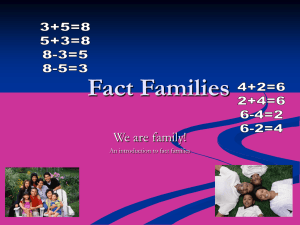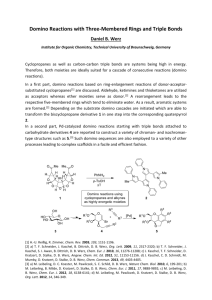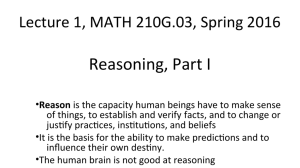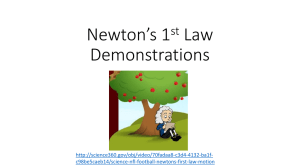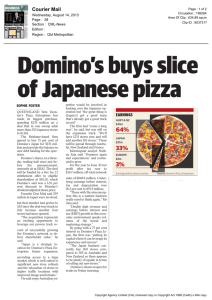Fight Viral with Viral: A Case Study of Domino's Pizza's Crisis
advertisement
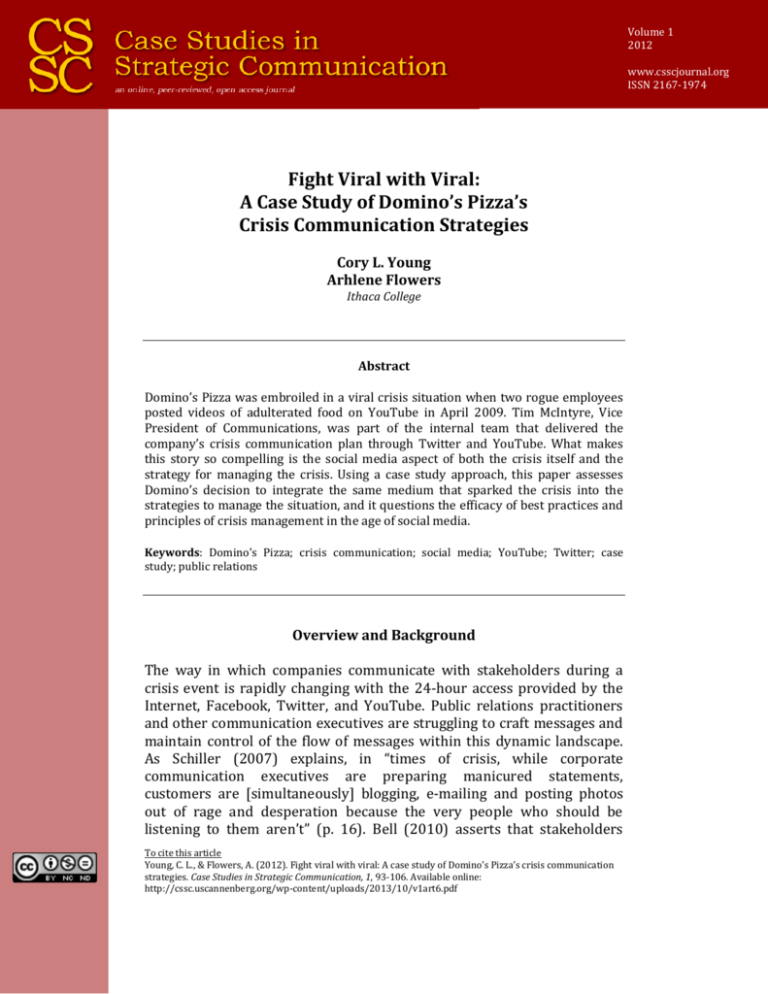
Volume 1 2012 www.csscjournal.org ISSN 2167-1974 Fight Viral with Viral: A Case Study of Domino’s Pizza’s Crisis Communication Strategies Cory L. Young Arhlene Flowers Ithaca College Abstract Domino’s Pizza was embroiled in a viral crisis situation when two rogue employees posted videos of adulterated food on YouTube in April 2009. Tim McIntyre, Vice President of Communications, was part of the internal team that delivered the company’s crisis communication plan through Twitter and YouTube. What makes this story so compelling is the social media aspect of both the crisis itself and the strategy for managing the crisis. Using a case study approach, this paper assesses Domino’s decision to integrate the same medium that sparked the crisis into the strategies to manage the situation, and it questions the efficacy of best practices and principles of crisis management in the age of social media. Keywords: Domino’s Pizza; crisis communication; social media; YouTube; Twitter; case study; public relations Overview and Background The way in which companies communicate with stakeholders during a crisis event is rapidly changing with the 24-hour access provided by the Internet, Facebook, Twitter, and YouTube. Public relations practitioners and other communication executives are struggling to craft messages and maintain control of the flow of messages within this dynamic landscape. As Schiller (2007) explains, in “times of crisis, while corporate communication executives are preparing manicured statements, customers are [simultaneously] blogging, e-mailing and posting photos out of rage and desperation because the very people who should be listening to them aren’t” (p. 16). Bell (2010) asserts that stakeholders To cite this article Young, C. L., & Flowers, A. (2012). Fight viral with viral: A case study of Domino’s Pizza’s crisis communication strategies. Case Studies in Strategic Communication, 1, 93-106. Available online: http://cssc.uscannenberg.org/wp-content/uploads/2013/10/v1art6.pdf Young & Flowers Fight Viral with Viral become “interpretive communities in organizational crisis contexts,” capable of cultivating an organization’s reputation through information they receive in cyberspace (p. 148). Social media allow stakeholders to control when, where, and how “reputational meanings are born and disseminated” as “an organization’s reputation is built on the stories formed by stakeholders and spread within networks” (Aula, 2011, p. 28, 30). Nowhere is this dynamic between organizations and their publics more apparent than on video sharing sites, such as YouTube, that encourage citizens and bloggers to be the co-producers of messages. Burgess and Green (2009) explain that YouTube users engage with this medium “as if it is a space specifically designed for them and that should therefore serve their own particular interests” (p. vii). This can have enormous positive or negative impacts for organizations involved in crisis management, including but not limited to the inability of boundary spanners to monitor the vastness of this space; malicious users who might create a crisis; and the leveraging capabilities of this platform to enhance a brand during a crisis. Just as consumers can use this social medium to create a crisis for a company and interpret an organization’s reputation throughout, so too can an organization use this medium to manage a crisis and improve its reputation. Patrick Doyle, President of Domino’s Pizza, would come to understand this dynamic as his brand suffered a devastating blow when two employees uploaded a vulgar video demonstrating their grotesque adulteration of food. Bob Garfield (2010), a writer for Ad Age Blogs, recounts in an online article how this incident began. On Easter Sunday in April 2009, two Domino’s employees who were bored “working in a North Carolina store figured it would be just hilarious to post a video of themselves, defiling sandwich ingredients” (para. 2). The duo created five videos in total, one of which showed an individual sticking mozzarella cheese up his nose and then blowing the cheese on a sandwich, among other unsanitary and stomachturning activities. An estimated 1 million people viewed these videos before they were pulled two days later. During the first 24 hours, Tim McIntyre, Vice President of Corporate Communications, surveyed the situation and determined that the videos were not a hoax. He then began to communicate internally and externally with “relevant audiences at that time [including] our social media people, our head of security, senior management team,” according to Amy Jacques Case Studies in Strategic Communication, 1 | 2012 94 Young & Flowers Fight Viral with Viral (2009) in an article published in The Public Relations Strategist (para. 4, 7). McIntyre collaborated with the consumer watchdog organization GoodAsYou.org, which first alerted Domino’s of the employee video, to identify the rogue employees as Kristy Hammond and Michael Setzer. By Tuesday, according to McIntyre, the company was responding to customers’ queries on Twitter about whether the company knew about the situation, what the company was doing, and why the company had not issued an official statement (Jacques, 2009). By Wednesday, Patrick Doyle, President of Domino’s Pizza, recorded an apology that was then uploaded onto YouTube. During this event, bloggers and journalists alike captured this crisis in articles and case studies, offering step-by-step timelines1 (Jacques, 2009; Peeples & Vaughn, 2010) and criticisms of Domino’s responses (Beaubien, 2009; Esterline, 2009; Gregory, 2009; Vogt, 2009; Weiss, 2009; York, 2009). What follows in this case study is an analysis of Domino’s crisis communication strategies, using a blend of best practices for crisis management from the principles of public relations management crafted by Arthur W. Page and from an academic perspective as the framework for analysis. From a communication perspective, according to Jaques (2008), case studies “are generally a narrative of events which are critically examined in relation to recognized public relations theories and models in order to fully appreciate what happened and to consider alternative strategies and outcomes” (p. 194), and are written to provide practical value to managers and practitioners alike who are struggling to manage and control the flow of messages in the viral/digital landscape (Coombs, 2008; “How Social Media,” 2009; Oneupweb, 2007). Research The Arthur W. Page Society is a professional organization for executives in the public relations and communication industries. Named after one of the first public relations executives to work for a Fortune 500 corporation (AT&T), this organization is charged with the goal of “embracing the highest professional standards; advancing the way communications is understood, practiced and taught; and providing a collegial and dynamic learning environment” (“Vision, Mission & Goals,” n.d., para. 2). According A visual timeline of the first four days is available on the Arthur W. Page’s website: http://www.awpagesociety.com/insights/winning-case-studies/2010/ 1 Case Studies in Strategic Communication, 1 | 2012 95 Young & Flowers Fight Viral with Viral to the Society’s website, the following principles are designed to guide public relations practitioners’ actions and behaviors and exemplify Page’s philosophy of public relations management: (1) Tell the truth; (2) Prove it with action; (3) Listen to the customer; (4) Manage for tomorrow; (5) Conduct public relations as if the whole company depends on it; (6) Realize a company’s true character is expressed by its people; and lastly, (7) Remain calm, patient and good-humored (“The Page Principles,” n.d.). These principles are similar to the 10 best crisis communication practices Seeger (2006) generated, based on the work of communication scholars and expert practitioners: 1. Process approaches and policy development; 2. Pre-event planning; 3. Partnership with the public; 4. Listen to the public’s concerns and understand the audience; 5. Honesty, candor, and openness; 6. Collaborate and coordinate with credible sources; 7. Meet the needs of the media and remain accessible; 8. Communicate with compassion, concern and empathy; 9. Accept uncertainty and ambiguity; and 10. Messages of self-efficacy. Veil, Buehner, and Palenchar (2011) extend Seeger’s best practices, incorporating social media tools by making social media engagement a part of risk and crisis management policies and procedures; incorporating social media when scanning the environment; being a part of rumor management to determine appropriate channels; and using social media to communicate updates in an interpersonal manner (pp. 119-120). Case Studies in Strategic Communication, 1 | 2012 96 Young & Flowers Fight Viral with Viral Compiling and synthesizing these practices is not an easy task as “crises and disasters are relatively unique in nature, inherently dynamic, and unpredictable” (Bell, 2010, p. 151). These practices, according the Seeger (2006) “do not constitute a plan, but are the principles or processes that underlie an effective crisis communication plan and effective crisis response” (p. 242). Given the nature of crises, these practices will unfold and evolve differently within each situation. Taking a situational approach to crisis communication, Coombs (2004) offers the Situational Crisis Communication Theory as an explanation for how organizations select a crisis response strategy. Essentially, a crisis triggers attributions of responsibility to the organization from stakeholders, along three dimensions: 1) whether the crisis has happened before or will likely happen again; 2) whether the event was controllable or uncontrollable by an individual or the organization; and 3) whether the crisis occurs within the organization or external to it. In this case, Domino’s as an organization was not directly responsible for this crisis, as the event occurred internally at the hands of employees, and this type of crisis had never happened before. Based on stakeholder attributions, an organization will respond communicatively by cycling through a four step process: 1) observe events; 2) interpret information for accuracy and relevance; 3) choose a strategy among alternatives; and 4) implement the solution (Hale, Dulek, & Hale, 2005). Ideally, the strategy chosen will be aligned with the best practices and principles articulated above and will follow the four step process. Did Domino’s follow the best practices outlined by Seeger and the Page principles? What were the brand’s overall actions, decisions, and strategies for managing the crisis? In the case of Domino’s, it was not the consumers’ attributions of responsibility to Domino’s that triggered the strategy. Rather, what triggered Patrick Doyle’s decision to deliver a video apology on YouTube was the medium itself, which begs the questions, How did social media impact or influence the decision making process?, and What crisis communication lessons were learned in the process? Strategies and Execution This first Page principle—Tell the truth—begs a series of questions about whose truth needs to be told and about what in particular. In crisis situations, multiple truths or social constructions of the event(s) are vying Case Studies in Strategic Communication, 1 | 2012 97 Young & Flowers Fight Viral with Viral for attention simultaneously: in general, customers, the company, its employees, and the media. In the case of Domino’s, particular watchdog organizations like GoodAsYou.org and Consumerist.com were also constructing versions of the event. The truth that Tim McIntyre, VP of Communications, wanted to convey was that this incident was “a rogue act of two individuals who thought they were being funny. That they do not represent this brand. That they do not represent the 100,000 people who work every day at Domino’s Pizza all over the world” (Flandez, 2009, para. 6). The truth that Patrick Doyle wanted to articulate was that “We didn’t do this. We’re sorry. And we want to earn your trust back” (Peeples & Vaughn, 2010, p. 3). However, in wanting to be honest, open and candid (Seeger, 2006) about the situation, Domino’s needed to take responsibility. However, taking responsibility had the potential of exposing the organization to lawsuits and other legal vulnerabilities (Claeys & Cauberghe, 2012), including freedom of speech and copyright claims. In order to mitigate the consequences of being truthful and minimize the damage to the organization’s reputation, the company collaborated and coordinated with credible sources (the watch dog organizations and local authorities) and partnered with the public to observe and interpret the events, so as to not “act too hastily and alert more consumers to the situation it was attempting to contain” (York, 2009, para. 5), and to not “add fuel to the online fire” (Levick, 2009, para. 5). Unfortunately, a consequence of following the principles and best practices was that a 24 hour lag occurred. Because Domino’s hesitated, customers began tweeting about whether the company actually knew what was happening and questioning what it was going to do about the videos. Veil, Buehner, and Palenchar (2011) point to the fact that “The power to communicate remains with the communicating organization and their behaviors and narrative content, not in the technology” (p. 120). A second challenge in telling the truth in the digital age hinges on additional questions (Roberts, 2010): Where in cyber and virtual spaces does an organization tell the truth and with what social medium or platform? York (2009) brought this to our attention in her online article, asking “why Domino’s has been lambasted for a lack of social media presence. After all . . . the brand is on MySpace, Twitter, YouTube and most visibly on Facebook with nearly 300,000 fans” (para. 18). There is a big difference, however, Case Studies in Strategic Communication, 1 | 2012 98 Young & Flowers Fight Viral with Viral between how emerging social media are used for marketing and how they work in a serious crisis situation . . . Companies that fail to integrate their marketing efforts with their online crisis response plans before a crisis hits are letting their antagonists have free reign. (Levick, 2009, para. 2-4) The first message acknowledging the crisis was uploaded onto the corporate website on the day after the offending videos had been posted, but the message hardly yielded any hits. Domino’s did not reach its most popular audience through this social medium. According to McIntyre, prior to this event, [the crisis team had a social media plan] already in place. We didn’t want to just jump in without a strategy. We wanted to do it right. So the irony for us was that we have a plan and we were going to implement it only a week later, so we ended up having to jump in [during] a crisis, which was the opposite of how we wanted to do it. (quoted in Jacques, 2009, para. 10) However, after listening to the customers/publics’ tweets, the company was compelled to speed up the implementation of the social media plan. A decision was made to [change] course and [respond] with a viral video . . . [that] featured all the elements of effective crisis communication. The company president apologized. He thanked the online community for bringing the issue to his attention. He separated the company from wrongdoers and announced their prosecution. And he outlined steps that Domino’s was taking to deal with the issue to make sure it never happens again (Levick, 2009, para. 6). This strategy and decision to fight the crisis’ viral nature using YouTube was the tipping point that allowed the company “to cull user-generated content from social networking sites and use the platform for distributing information back to users” in order to prove itself with action and to communicate with passion, concern and empathy (Veil et al., 2011, p. 114). Levick (2009), in an online article for Bloomberg Businessweek, stipulated that “Domino’s not only demonstrated concern for its customers, but also an understanding of the critical importance of reaching out to a target Case Studies in Strategic Communication, 1 | 2012 99 Young & Flowers Fight Viral with Viral audience on its own terms and in its own preferred space” (para. 7). This strategy and decision also suggests that Domino’s has the ability to manage the crisis for tomorrow: “This crisis happened online. It had to be dealt with online. By learning that lesson under fire Domino’s broke new ground and opened a new chapter in the ongoing evolution of crisis communications” (Levick, 2009, para. 7). Evaluation & Discussion Arthur W. Page advocated for public relations practitioners to tell the truth, a laudable goal to aspire to, but nonetheless one that is increasingly challenging in today’s digital era. Initially, Domino’s relied on its traditional technology (the Internet) to upload a video response on its corporate website to tell the public the truth about the situation. However, the number of people who viewed this video paled in comparison to the number of YouTube viewers who watched the employee prank videos— over one million within 24 hours. This realization accelerated and expedited the implementation of Domino’s social media plan that was still in development. The crucial lesson to be learned about crisis communication comes in the form of extending and aligning the Situational Crisis Communication Theory with best practices for the integrating of social media (Veil et al, 2011). Coombs (2004) stipulated that a crisis triggers stakeholders’ attributions regarding the organization’s level of responsibility. These attributions, in turn, influence the strategy that an organization will use to lessen the damaging effects. In this case, however, it was not stakeholder attributions that dictated Domino’s strategy, but rather it was the social medium in which the crisis occurred that shaped the company’s decision to respond on YouTube as well as its overall strategy. The only way to combat and lessen the impact of a social media generated crises like what Domino’s experienced is to integrate social media into crisis communication strategies and to create strategies for monitoring social media dialogue (Tinker, Fouse, & Currie, 2009). Schiller (2007) agrees that “Brands that get it right will be the ones that will use the same online tools as their customers” (p. 16). Further, Peeples and Vaughn (2010) concluded that Domino’s “effectively leveraged social media – the same channel used by the pranksters – to transparently communicate the company’s efforts to address the situation” (p. 1).The end result was that Case Studies in Strategic Communication, 1 | 2012 100 Young & Flowers Fight Viral with Viral Domino’s emerged from this vulnerability criticized, yet knowledgeable about the reality of crisis communication in the age of social media. The reality of crisis communication today is complex and contradictory. The speed at which consumers generate information about organizations is surpassing the speed by which public relations practitioners can monitor and verify the validity of such content, in order to respond before, during, and after a crisis incident. Because social media users can instantaneously create visual and textual dialogue with an organization, there is a corresponding expectation that organizations should respond just as quickly throughout all phases of a crisis incident. But taking the time to verify information and craft appropriate and effective responses is necessary to avoid legal issues and other complications. This dynamic has several implications for: 1. How often organizations need to communicate with stakeholders: Regular updates across multiple social media should occur, using such platforms as HootSuite or Bottlenose to ensure consistency. 2. How far and wide organizations need to span the boundaries of cyberspace and social media for potential crises and for potential stakeholder groups that can be impacted and affected: Johnson, Bazaa, and Chen (2011) conducted a study on boundary spanning, concluding that “organizations should focus on recruiting, attracting, and nurturing those online users with high levels of enduring involvement and social identity,” i.e., highly engaged social media users (p. 15). 3. How organizations can manage their online reputations through search engine optimization (SEO). 4. How new principles and best practices need to be developed to determine what messages or images from which stakeholder groups will tip towards a crisis. As organizations grapple with these new directions, employees and consumers will need to learn how to accept uncertainty and ambiguity, and remain calm, patient and good humored. Case Studies in Strategic Communication, 1 | 2012 101 Young & Flowers Fight Viral with Viral Discussion Questions 1. What impact does social media have on public relations practices, particularly crisis communications and reputation management? How significant is it for organizations today to monitor content on social media sites, including hash tags and other signs of internal and external dialogue? 2. How should crisis communications preparedness plans address the proliferation of social media outlets? 3. From the perspective of crisis communicators concerned with social media, what else could Domino’s have done or said to prove with action that its key messages are sincere? What other messages could Domino’s have delivered? 4. What other types of traditional media and social media could Domino’s have used to reach its stakeholders? 5. What other challenges do you think that PR practitioners, marketers, or corporate communicators could have in telling the truth in the digital age? 6. How important is speed of response rate in a digital world, particularly when an organization is facing a crisis situation? 7. Are there any other conclusions that you can draw from this incident? Learning Activities 1. According to its website, Media Curves “is the leader in public perception of topical issues.” This communications research company uses its patent pending technology to evaluate the “believability” of a particular video, such as the apology posted on YouTube by Domino Pizza’s President Patrick Doyle. To see how Media Curves’ technology captured people’s perceptions of Doyle’s apology video, watch Doyle’s apology video here: http://www.youtube.com/watch?v=uFiXWboPD5A. Discuss the specific moments in the video that people found most believable and Case Studies in Strategic Communication, 1 | 2012 102 Young & Flowers Fight Viral with Viral least believable and what public relations practitioners can learn from studies like this. Visit the Media Curves website to watch other assessments of video apologies. 2. Using the framework presented in this article, apply the Arthur W. Page Society’s principles (“Vision, Mission & Goals,” n.d.), Seeger’s (2006) best practices, and Veil, Buehner, and Palenchar’s (2011) suggestions for integrating social media to United Airlines and its handling of Dave Carroll’s “United Breaks Guitar Video” or to Providence Renaissance and its handling of “Joey Quits” video. What lessons can be learned about social media and crisis communication from analyzing these organizations’ strategies? 3. To see how Domino’s has dealt with this crisis, consider some background information about its Pizza Turnaround campaign. How does this compare with the best practices? How did tweets like #newpizza help? References Aula, P. (2011). Meshworked reputation: Publicists’ views on the reputational impacts of online communication. Public Relations Review, 37, 28-36. Beaubien, G. (2009, April 21). Domino’s YouTube flap: ‘A landmark event in crisis management.’ Public Relations Tactics. Retrieved December 31, 2012, from http://www.prsa.org/SearchResults/view/7978/105/ Domino_s_YouTube_flap_a_landmark_event_in_crisis_m Bell, L. M. (2010). Crisis communication: The praxis of response. The Review of Communication, 10(2), 142-155. Burgess, J., & Green, J. (2009). YouTube: Online video and participatory culture. Malden, MA: Polity Press. Claeys, A., & Cauberghe, V. (2012). Crisis response and crisis timing strategies, two sides of the same coin. Public Relations Review, 38, 83-88. Coombs, W. T. (2004). Impact of past crises on current crisis communication: Insights from Situational Crisis Communication Theory. Journal of Business Communication, 41(3), 265-289. Coombs, W. T. (2008, April 2). Crisis communication and social media. Institute for Public Relations. Retrieved December 31, 2012, from http://www.instituteforpr.org/topics/crisis-communication-and-social-media/ Esterline, R. M. (2009, April 25). Case study: Domino’s YouTube video. Retrieved December 31, 2012, from http://crisiscomm.wordpress.com/2009/04/25/case-study-dominos Case Studies in Strategic Communication, 1 | 2012 103 Young & Flowers Fight Viral with Viral Flandez, R. (2009, April 20). Domino’s response offers lessons in crisis management. The Wall Street Journal. Retrieved December 31, 2012, from http://blogs.wsj.com/independentstreet/2009/04/20/ dominos-response-offers-lessons-in-crisis-management Garfield, B. (2010, January 11). Domino’s does itself a disservice by coming clean about its pizza: We like apologies and honesty, but there are limits. Just ask Ford. Ad Age Blogs. Retrieved December 31, 2012, from http://adage.com/ article/ad-review/advertising-domino-s-a-disservice-ads/141393 Gregory, S. (2009, April 18). Domino’s YouTube crisis: Five ways to fight back. Time Magazine. Retrieved December 31, 2012, from http://www.time.com/time/nation/article/0,8599,1892389,00.html Hale, J. E., Dulek, R. E., & Hale, D. P. (2005). Crisis response communication challenges: Building theory from qualitative data. Journal of Business Communication, 42(2), 112-134. How social media are changing crisis communications—for better and worse. (2009, November 1). Security Director’s Report, 9(11), 2-5. Jacques, A. (2009, August 17). Domino’s delivers during crisis: The company’s stepby-step response after a vulgar video goes viral. The Public Relations Strategist. Retrieved December 31, 2012, from http://www.prsa.org/Intelligence/TheStrategist/Articles/ view/8226/102/Domino_s_delivers_during_crisis_The_company_s_step Jaques, T. (2008). A case study approach to issue and crisis management: Schadenfreude or an opportunity to learn? Journal of Communication Management, 12(3), 192-203. Johnson, P. R., Bazaa, U., & Chen, L. (2011, May). The new boundary spanners: Social media users, engagement, and public relations outcomes. Paper presented at the annual meeting of the International Communication Association, Boston, MA. Retrieved December 31, 2012, from http://www.icavirtual.com/ wp-content/uploads/2011/05/FULL-PAPER-SUBMISSION-TEMPLATE-EK1.pdf Levick, R. S. (2009, April 21). Domino’s discovers social media. Bloomberg Businessweek. Retrieved December 31, 2012, from http://www.businessweek.com/print/managing/content/ apr2009/ca20090421_555468.htm Oneupweb. (2007). Principles of crisis management in a viral age: Integrating the tools and lessons of search 2.0 into a comprehensive crisis response [White paper]. Traverse City, MI: Oneupweb. Retrieved December 31, 2012, from http://internetetopinion.files.wordpress.com/2008/01/crisis_management.pdf The Page principles. (n.d.). Arthur W. Page Society. Retrieved December 31, 2012, from http://www.awpagesociety.com/about/the-page-principles/ Peeples, A. & Vaughn, C. (2010). Domino’s “special” delivery: Going viral through social media (Parts A & B). Arthur W. Page Society case study competition in corporate communications. Retrieved December 31, 2012, from http://www.awpagesociety.com/insights/winning-case-studies/2010 Case Studies in Strategic Communication, 1 | 2012 104 Young & Flowers Fight Viral with Viral Roberts, J. (2010, March 18). Bringing your brand back from the brink. Marketing Week. Retrieved December 31, 2012, from http://www.marketingweek.co.uk/ bringing-your-brand-back-from-the-brink/3011206.article Schiller, M. (2007, March 5). Crisis and the web: How to leverage the Internet when a brand takes a hit. Adweek, 48(10), 16. Seeger, M. W. (2006). Best practices in crisis communication: An expert panel process. Journal of Applied Communication Research, 34(3), 232-244. Tinker, T., Fouse, D. (Eds.), & Currie, D. (Writer). (2009). Expert round table on social media and risk communication during times of crisis: Strategic challenges and opportunities [Report]. Washington, DC: American Public Health Association. Retrieved December 31, 2012, from http://www.apha.org/NR/rdonlyres/ 47910BED-3371-46B3-85C2-67EFB80D88F8/0/socialmedreport.pdf Veil, S. R., Buehner, T., & Palenchar, M. J. (2011). A work-in-progress literature review: Incorporating social media in risk and crisis communication. Journal of Contingencies and Crisis Management, 19(2), 110-122. Vision, mission & goals. (n.d.). Arthur W. Page Society. Retrieved December 31, 2012, from http://www.awpagesociety.com/about/vision-misson-goals/ Vogt, P. (2009, April 24). Brands under attack: Marketers can learn from Domino’s video disaster. Forbes. Retrieved December 31, 2012, from http://www.forbes.com/2009/04/24/ dominos-youtube-twitter-leadership-cmo-network-marketing.html Weiss, T. (2009, April 22). Crisis management—Domino’s case study research. Trendsspotting Blog. Retrieved December 31, 2012, from http://www.trendsspotting.com/blog/?p=1061 York, E. B. (2009, April 20). What Domino’s did right--and wrong--in squelching hubbub over YouTube video. Advertising Age [Online]. Retrieved December 31, 2012, from http://adage.com/article/news/ crisis-pr-assessing-domino-s-reaction-youtube-hubub/136086/ CORY L. YOUNG, Ph.D., is an associate professor of communication management and design in the Department of Strategic Communication, Roy H. Park School of Communications, at Ithaca College in Ithaca, New York, where she teaches courses in corporate communication. Email: youngc[at]ithaca.edu. ARHLENE FLOWERS is an associate professor of integrated marketing communications in the Department of Strategic Communication, Roy H. Park School of Communications, at Ithaca College in Ithaca, New York, where she teaches courses in public relations. Email: aflowers[at]ithaca.edu. Acknowledgments This manuscript was made possible in part by a James B. Pendleton grant from the Roy H. Park School of Communications at Ithaca College. A version of this Case Studies in Strategic Communication, 1 | 2012 105 Young & Flowers Fight Viral with Viral paper was presented at the International Communication Association’s preconference hosted in Tokyo, Japan, June 2010. Additionally, the following graduate assistants need to be acknowledged for their research contributions: Rui Liu, Savitha Ranga, Nate (Zheli) Ren, and Danielle Clarke. Editorial history Received November 4, 2011 Revised April 9, 2012 Accepted June 12, 2012 Published December 31, 2012 Handled by editor; no conflicts of interest Case Studies in Strategic Communication, 1 | 2012 106
